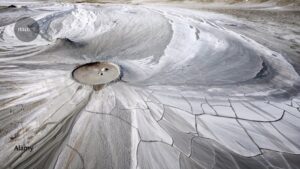GS1 – Geography

Context:
Recently, Taiwan’s Wandan mud volcano erupted.
What are Mud Volcanoes?
- Mud volcanoes are geological formations caused by the eruption of mud, water, and gases—not lava or molten rock.
- Their eruptions are usually cool, in contrast to the high-temperature eruptions of magmatic volcanoes.
- They do not involve lava or magma and typically release methane, carbon dioxide, and nitrogen, often under significant pressure.
- Some mud volcanoes erupt continuously, while others erupt intermittently.
- Though generally less explosive, they can ignite fires due to the flammable gases emitted.
Why Do Mud Volcanoes Catch Fire?
- Methane and other hydrocarbon gases may ignite naturally from surface heat or be set on fire deliberately—as seen in the Wandan eruption, where locals burned escaping methane.
- Friction between rocks during gas movement through geological fractures can also lead to ignition.
- Electrical discharges from gas clouds may ignite methane-rich plumes, causing spontaneous combustion.
Types of Mud Volcanoes
- Cold Mud Volcanoes:
- Release cool mud and gases.
- Not associated with geothermal activity.
- Hot Mud Volcanoes:
- Emit warmer substances.
- Linked to subduction zones and geothermal regions.
- Island Mud Volcanoes:
- Occur offshore, sometimes forming temporary islands of mud.
- Onshore Cone Domes:
- Dome-shaped features on land.
- Typically found in petroleum-rich sedimentary basins.
Comparison: Mud Volcanoes vs Regular (Magmatic) Volcanoes
| Feature | Mud Volcanoes | Regular Volcanoes |
| Eruption Material | Mud and gases | Lava and ash |
| Heat Source | Surface-level gases | Magma from deep within the Earth |
| Explosiveness | Low | High |
| Geological Origin | Shallow crust | Deep-seated in Earth’s mantle |
| Hazards | Fires, land subsidence | Lava flows, ash clouds, pyroclastic flows |




